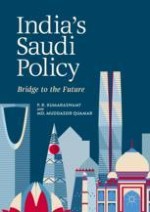2019 | OriginalPaper | Chapter
2. The Nehru Era
Authors : P. R. Kumaraswamy, Md. Muddassir Quamar
Published in: India's Saudi Policy
Publisher: Springer Singapore
Activate our intelligent search to find suitable subject content or patents.
Select sections of text to find matching patents with Artificial Intelligence. powered by
Select sections of text to find additional relevant content using AI-assisted search. powered by
